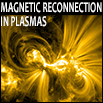Speaker
Dr
Mikhail Belyaev
(Theoretical Astrophysics Center UC Berkeley Astronomy Department)
Description
We perform 2.5D axisymmetric simulations of the pulsar
magnetosphere (aligned
dipole rotator) using the charge conservative, relativistic,
electromagnetic particle
in cell code PICsar. Particle in cell codes are a powerful tool to
use for studying the
pulsar magnetosphere, because they can handle the force-
free and vacuum limits
and provide a self-consistent treatment of magnetic
reconnection. In the limit of
dense plasma throughout the magnetosphere, our solutions
are everywhere in the
force-free regime except for dissipative regions at the polar
caps, in the current
layers, and at the Y-point. These dissipative regions arise
self-consistently, since we
do not have any explicit dissipation in the code. A minimum
of $ \approx 15-20\%$
of the electromagnetic spindown luminosity is transferred to
the particles inside 5
light cylinder radii. However, the particles can carry as much
as $\gtrsim 50 \%$ of
the spindown luminosity if there is insufficient plasma in the
outer magnetosphere
to screen the component of electric field parallel to the
magnetic field. In reality,
the component of the spindown luminosity carried by the
particles could be radiated
as gamma rays, but high-frequency synchrotron emission
would need to be
implemented as a sub-grid process in our simulations and is
not present for the
current suite of runs. The value of the spindown luminosity in
our simulations is
within $\approx 10\%$ of the force-free value, and the
structure of the
electromagnetic fields in the magnetosphere is on the whole
consistent with the
force-free model.
Primary author
Dr
Mikhail Belyaev
(Theoretical Astrophysics Center UC Berkeley Astronomy Department)

